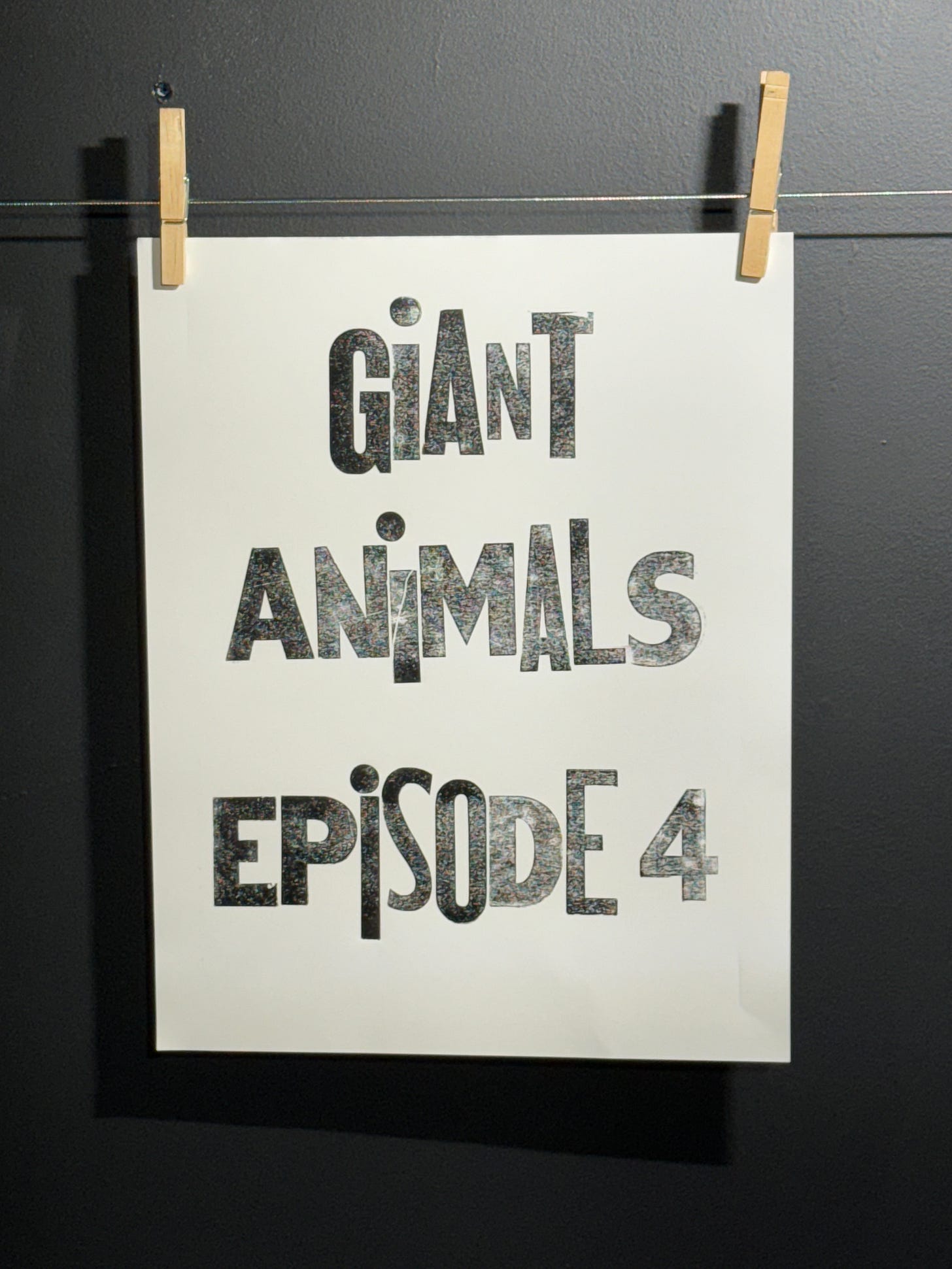The Show Notes: Rabbit Hole of Research Episode 4: Giant Animals
Nick and Joe chat about Giant Animals in movies and fiction.

Episode 4: The Show Notes
This has no particular format; it's just correcting or updating anything in the show we didn’t get a chance to fully talk about or things we had on the tips of our tongues and couldn’t get out as we recorded. As always, feel free to comment, and we will address stuff in future shows! Enjoy.
What we drinking:
Joe: Phony Negroni —St. Argrestis
Nick: Water
Let us know:
What’s your favorite animal?
What’s your favorite giant animal movie?
Favorite color?
Show notes:
Technically any plane carrying the president is designated as Air Force One:
Air Force One (1997) movie
What is Dry January
Food of the Gods 1976 movie
Food of the Gods Novel by H.G. Wells

Let the Ants Try by Frederik Pohl (short story)
Where do sloths live?
Sloths are found throughout Central America and northern South America, including parts of Brazil and Peru
Who sings song—“You and me, baby, ain't nothin' but mammals So let's do it like they do on the Discovery Channel”?
Bloodhound Group—‘The Bad Touch’
Aldi and Trader Joe’s history
E. L. Doctorow: Homer and Langley—universal newspaper
Seanan McGuire (Mira Grant) Into the Drowning Deep
Pushing beached whales into ocean?
Whalefall—Daniel Kraus
Largest land animal
The African Elephant (Loxodonta africana) holds the title for the largest land animal. Adult male African elephants can weigh between 5,000 to 14,000 pounds (2,268 to 6,350 kilograms) and stand about 8.2 to 13 feet (2.5 to 4 meters) tall at the shoulder. Female African elephants are generally smaller than males but still large compared to other land animals.
It’s worth noting that the size of elephants can vary, and these measurements are approximate. The African Elephant’s large size is a testament to its adaptation to diverse habitats across the African continent.
Largest sea animal
The blue whale (Balaenoptera musculus) holds the title for the largest sea animal and, in fact, the largest animal on Earth. Adult blue whales can reach lengths of up to 100 feet (30 meters) and weigh as much as 200 tons. These enormous marine mammals are filter feeders, primarily consuming small shrimp-like animals called krill.
The sheer size of blue whales is remarkable, and they are found in oceans around the world, making them a truly global species. Despite their massive size, blue whales are gentle creatures, and their conservation status is classified as endangered due to historical whaling practices. Conservation efforts are ongoing to protect and preserve these magnificent marine animals.
The size of animals is constrained by various biological, ecological, and physical factors. Some limitations include:
1. Metabolic Demands: Larger animals generally have higher metabolic demands. Meeting these demands becomes challenging, as it requires sufficient food intake, efficient energy utilization, and effective waste removal.
2. Support Structures: The strength of bones, muscles, and other support structures is crucial. Beyond a certain size, the ability to support the body’s weight becomes a limiting factor.
3. Respiratory System: Diffusion-based respiratory systems become less effective as an organism grows larger. Efficient gas exchange becomes challenging, potentially limiting the maximum size of animals relying on this mechanism.
4. Heat Dissipation: Larger animals face challenges in dissipating heat efficiently. This is due to the decrease in surface area relative to volume, affecting heat exchange with the environment.
5. Reproductive Challenges: Larger animals often have fewer offspring and longer gestation periods. This could impact reproductive strategies and population dynamics.
6. Predator-Prey Dynamics: Size affects the ability to evade predators or capture prey. Both extreme sizes, very large or very small, can be disadvantageous in certain ecological niches.
7. Evolutionary Pressures: Evolutionary pressures may favor smaller sizes in specific environments, promoting agility, rapid reproduction, and adaptability over large size.
8. Ecological Niche: Each species occupies a specific ecological niche, and the size of an organism is often adapted to its role in the ecosystem. Deviating too much from the optimal size for a given niche could be disadvantageous.
Sources:
• Schmidt-Nielsen, K. (1984). Scaling: Why is Animal Size So Important? Cambridge University Press.
The size of insects is constrained by various biological and physical factors. Here are some key limitations:
1. Exoskeleton: Insects have an exoskeleton made of a rigid material called chitin. As they grow, they need to molt and shed their exoskeleton to accommodate a larger size. This process becomes more challenging as the insect gets larger due to the increased structural demands.
2. Respiratory System: Insects rely on a system of tiny tubes called tracheae for respiration. As they grow larger, the surface area available for gas exchange becomes insufficient, limiting their ability to provide oxygen to all cells effectively.
3. Muscle Efficiency: The efficiency of muscle function decreases as insects get larger. The relationship between muscle strength and size is not linear, and larger insects may face challenges in coordinated movement and efficient muscle function.
4. Metabolic Rate: Larger insects might struggle to meet the metabolic demands associated with increased body size. Efficient energy utilization becomes a limiting factor, affecting overall viability.
5. Predation: Larger insects may become more vulnerable to predators. Their size makes them easier targets, and the advantages of being smaller, such as agility and concealment, become essential for survival.
6. Feeding Efficiency: As insects grow larger, their feeding efficiency might decrease. The energy required to forage for food may surpass the energy gained from the food itself.
7. Developmental Constraints: The developmental processes of molting and metamorphosis, which are integral to an insect’s life cycle, impose limitations on the attainable size.
8. Environmental Conditions: In certain environments, such as those with limited oxygen concentration, larger insects might struggle to obtain sufficient oxygen, further restricting their size.
9. Evolutionary Trade-offs: Evolutionary pressures may favor smaller sizes in certain ecological niches due to trade-offs between size, reproductive strategies, and adaptation to specific environments.
Sources:
• Chapman, R. F., Simpson, S. J., & Douglas, A. E. (2013). The Insects: Structure and Function. Cambridge University Press.
Limitations of size for Animals Living in Water:
1. Buoyancy: Water provides buoyancy, supporting the weight of aquatic organisms. This allows for the existence of much larger animals in water compared to on land, where the gravitational pull is a more significant constraint.
2. Respiration: Aquatic animals often have gills, enabling efficient extraction of oxygen from water. This allows for a more effective respiratory system, potentially sustaining larger body sizes.
3. Swimming Efficiency: The streamlined shape and reduced effects of gravity in water allow for efficient movement, enabling larger sizes for aquatic animals. Whales, for example, are among the largest animals on Earth and are adapted to life in the oceans.
4. Food Availability: Water ecosystems can support larger populations of prey items, providing a more abundant food supply for predators. This abundance can contribute to the development of larger species.
5. Temperature Regulation: Water provides a more stable environment for temperature regulation. This stability can support larger animals that might face challenges related to temperature fluctuation on land.
Sources:
• Alexander, R. McN. (2006). Principles of Animal Locomotion. Princeton University Press.
• Vogel, S. (1994). Life in Moving Fluids: The Physical Biology of Flow. Princeton University Press.
The concept of an animal growing 10 times its natural size in fiction, using a lot of Handwavium!
1. Extreme Nutrient Density: An exceptionally nutrient-dense food source could potentially fuel rapid and substantial growth in an animal. This might include a novel substance with highly concentrated essential nutrients that the animal can efficiently assimilate.
2. Genetic Modification: In a fictional context, genetic modification or engineering could play a role. Introducing genes that enhance growth, metabolism, or nutrient absorption might result in animals reaching sizes beyond their natural limits.
3. Magical or Extraterrestrial Influence: In a fantastical setting, magical elements or extraterrestrial factors could be introduced. For example, exposure to a magical substance or an extraterrestrial nutrient could trigger extraordinary growth in the animal.
4. Biological Anomaly: A rare biological anomaly or mutation that dramatically increases an animal’s growth rate could be part of the fictional narrative. This could involve an unexpected interaction between the animal’s genetics and a specific type of food.
5. Artificial Growth Stimulants: In a speculative scenario, the presence of artificial growth stimulants, either intentionally or accidentally introduced into the animal’s environment, could lead to accelerated growth.
Various mythologies, religions and fictions around the world feature giant animals, often portraying them as powerful, mythical beings or creatures with extraordinary abilities. Here are some examples:
1. Jormungandr (Norse Mythology): Jormungandr, also known as the Midgard Serpent, is a giant sea serpent in Norse mythology. It is said to encircle the Earth, grasping its tail in its mouth. According to prophecy, Jormungandr will play a significant role in the events leading to Ragnarok, the end of the world.
2. Nemean Lion (Greek Mythology): In Greek mythology, the Nemean Lion was a colossal, supernatural lion with an impenetrable golden fur. It was one of the Labors of Hercules to defeat this fierce lion.
3. Kaiju (Japanese Mythology/Fiction): While not strictly part of ancient mythology, Japanese kaiju are giant monsters often featured in modern fiction and films. Examples include Godzilla, Mothra, and Rodan, representing colossal creatures with destructive powers.
4. Garuda (Hindu and Buddhist Mythology): Garuda is a mythical bird or bird-like creature in Hindu and Buddhist traditions. It is often depicted as large, with the ability to carry off elephants. Garuda is a divine companion of the god Vishnu.
5. Fenghuang (Chinese Mythology): The Fenghuang, also known as the Chinese Phoenix, is a mythical bird in Chinese mythology. It is often described as a giant and colorful bird with various supernatural abilities, symbolizing grace and longevity.
6. Yamata no Orochi (Japanese Mythology): Yamata no Orochi is an eight-headed and eight-tailed dragon or serpent in Japanese mythology. It was defeated by the storm god Susanoo, and one of its tails contained the legendary sword Kusanagi.
7. Bunyip (Australian Aboriginal Mythology): The bunyip is a mythical creature from Australian Aboriginal mythology, often described as a large, amphibious monster inhabiting waterholes, rivers, and swamps.
8. Simurgh (Persian Mythology): The Simurgh is a mythical bird-like creature in Persian mythology. It is often portrayed as a large, benevolent bird with magnificent plumage, sometimes said to possess healing powers.
Okay, that’s it for this episode. How’d we do?
You can always email (I do answer back), click the comment link below, or follow me online for real time tracking.



